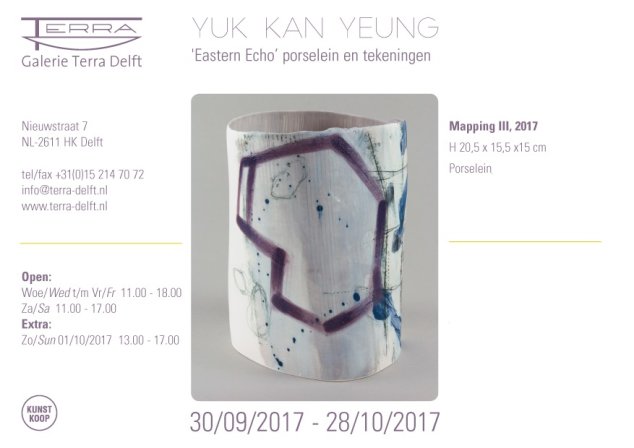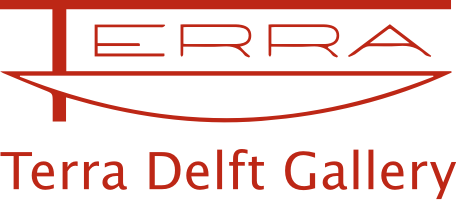Yuk Kan Yeung has developed two concepts for this solo exhibition. Both are based on two experiences she had in the past three years and which have shaped her recent work.
The first was an ‘artist in residence’ period in Jingdezhen in 2014. The other was a drawing project in Oosterhout, NL, in 2016.
In 2014 Yeung traveled to Jingdezhen with Galerie Terra Delft for an artist-in-residence program and resided at the Sanbao Ceramics Institution. ‘Every day I saw the green mountains and heard the rushing river; I was completely back in the Chinese landscape and culture. Just as a traveler coming home, I felt comfort, but also conflicts. I was rooted in my own culture; memories come and go, imperceptibly and still tangibly.’ A trip to the ancient villages of Yaoli and Dongbu and a bus trip to Shanghai in the pouring rain evoked a surge of emotions. ‘I was greatly moved and since then I have done more calligraphy.’
The essence of Chinese calligraphy is lines, the movement, the balance in composition, light and dark, the emotions and mood of the artist. ‘You search for a balance between light and dark, you dance with the lines. That concentration leads to deep feelings, a connection with your own soul.’
In 2016 Yeung took part in the ‘365+1 drawing project’ in Oosterhout. In the course of the year she made 366 drawings, watercolors and ink paintings on 10×10 cm. paper. ‘I became more aware of my surroundings.’ The forms and colors of nature, the changing of the seasons, the books she read and her emotions at that moment all formed sources of inspiration for this project.
These two experiences translated into two developments in Yeung’s recent work. In the first place, the drawing project has evolved so that she now sketches on porcelain instead of paper. To this end, she rolls the porcelain into a thin plate and builds it up until it can stand on its own, forming a gentle movement reminiscent of paper. She uses her intuition to nudge the movement further. ‘This simple cylinder form allows me to draw and paint more freely.’ Sometimes she first applies a monoprint to the clay and paints further after the bisque firing. For both techniques she uses colored porcelain slip and a ceramic pencil. Yeung’s point of departure is the discovery of the tension between in- and out-of-balance. The ceramic piece is like a rolled-up sheet of paper, tender with anticipation of the meeting with a play of lines.
Yeung’s other idea is more complex. Through the years she has practiced a great deal of calligraphy on rice paper. She has finally found a destination for this extensive collection. ‘I tore them up very finely and worked them into a paper pulp. I blend this fine fiber with porcelain clay and build up this rice paper-porcelain into a sculptured form.’ The resulting form is inspired by the lines and the movement in her drawings and calligraphy, and an abstract, spacious drawing emerges. The time-consuming process serves as meditation, comparable to the numerous calligraphy exercises which she has been doing since the age of six. ‘This almost ritualistic manner of working has brought me closer to my own culture; the calligraphy is incinerated in the oven and is resurrected as new work. An animized representation of unending moments in time and in space, hence the title ‘Eastern Echo’.
In addition to porcelain objects, Yeung will also display a number of drawings on paper in this exhibition.
Yuk Kan Yeung was born in Hong Kong and graduated from the Chinese University of Hong Kong in 1981 with a degree in fine arts. In 1987 she obtained a postgraduate degree in ceramics from Goldsmiths College, University of London. Since 1987 she has lived and worked in the Netherlands.
Also see her publication in KLEIkeramiek magazine on our website at ‘news’. And on YouTube you can see a documentary about her work made by Kleine K, a digital ceramic magazine: copy paste the following address



